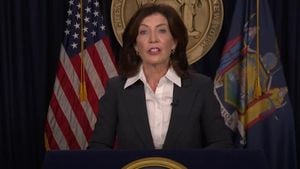Delhi, the capital of India, is currently engulfed by one of the worst air pollution crises it has faced, prompting widespread concern among residents and authorities alike. Recently reported air quality levels have skyrocketed, with the Air Quality Index (AQI) reaching alarming numbers, significantly deteriorated to levels never seen before. Just this week, at around 9 am on Tuesday, the AQI measured at a staggering 488, with out of 32 monitoring stations, 31 recording figures over 480, pushing two stations to peak at the maximum level of 500. This worrying trend doesn’t mark the first occurrence; last Monday, Delhi experienced its second-worst air quality reading recorded over the past six years, hitting 494. Not only does this impact health, but the subsequent fallout is disrupting daily life for countless residents.
The local government and authorities have responded with stringent measures. The Commission for Air Quality Management's (CAQM) enforcement of Stage IV under the Graded Response Action Plan (GRAP) has initiated strict pollution control measures intended to curb the choking haze engulfing the City. To alleviate the public health crisis, restrictions have included the ban on non-essential trucks entering the city, halting public construction projects, and implementing work-from-home policies for private sector offices.
Widespread shutdowns are even affecting educational institutions. The University of Delhi recently announced the suspension of all physical classes, transitioning immediately to online formats as pollution levels remained dangerously high. This decision follows directives from the Supreme Court, which insisted on the complete suspension of physical education for Classes 10 and 12, pressing concerns about the health impacts related to the severe air quality. Delhi’s schools from grades 9 to 11 have also been instructed to switch to online lessons until the air quality improves significantly.
Public sentiment reflects growing frustration as residents hunker down indoors to avoid the toxic air. Street vendors and small businesses report sharp drops in customer footfall, adversely affecting their livelihoods. Tea vendor Shyam Kala lamented, "Due to pollution, there is a lesser influx of customers because they are not stepping out of their homes." Others, like juice vendor Zubair Ahmed, complained about acute sales plummeting, worsened by the closure of schools and colleges. The economic repercussions of the air pollution crisis could ripple extensively, threatening small businesses and the broader informal economy.
The impact of air pollution reaches beyond immediate health concerns. For example, around the globe, air pollution leads to the loss of 1.2 billion workdays annually, with projections indicating this figure could escalate to 3.8 billion by 2060. Once again, the Indian economy felt the detrimental effects of pollution, which cost it nearly $95 billion back in 2019 due to reduced productivity and health-related absences. Uninspiring air quality has made Delhi less appealing for talent recruitment, effectively driving some corporations to seek alternative locations.
Efforts by lawmakers, like Congress MP Shashi Tharoor, to highlight the pollution crisis reflect mounting concerns about both the health impacts and the inherent flaws within the response strategies of the government. Tharoor criticized authorities, calling the air quality situation “unconscionable” and questioned Delhi’s viability as the national capital amid such hazardous conditions. He expressed his frustration over government inactivity, recalling attempts to rally experts to address air quality issues since 2015, claiming progress has remained stagnant, leading him to abandon those initiatives.
The Supreme Court has also been vocal, emphasizing the government's failure to manage air quality effectively. The court has warned authorities to maintain GRAP Stage IV measures until the air quality improves significantly, showcasing the urgency of the matter. The emphasis on public health is not just limited to the vulnerable populations; doctors have raised alarms over breathing difficulties and respiratory ailments affecting even otherwise healthy individuals.
Looking forward, the challenges facing Delhi underline the urgency for systemic changes throughout various sectors—from introducing cleaner supply chains to reevaluations of urban planning strategies. The health and environmental crises illuminated by the air pollution scandal warrant significant attention and action if the central government wishes to reclaim the capital’s air quality and protect its residents from such hazardous living conditions.
With air pollution levels continuing to rise and air quality becoming ever more perilous, residents are left wondering about the immediate and long-term solutions to this pressing crisis. The need for comprehensive strategies should align with grassroots community engagement, fostering proactive measures to address not only air quality but also the broader environmental concerns impacting their lives. While air pollution has always been part of the seasonal narrative affecting Delhi, the time is now to make impactful changes to safeguard public health and the integrity of life within the national capital.



